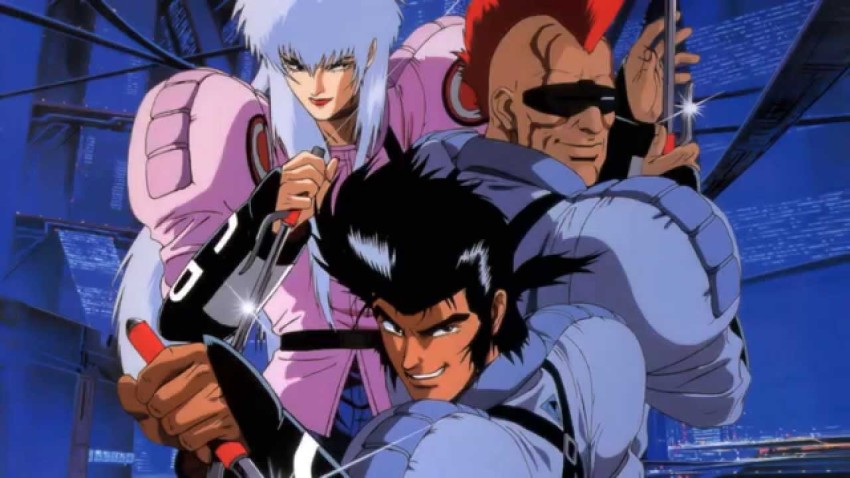Cyber City Oedo 808
October 7, 2018 · 0 comments
By Raz Greenberg.
 In the last two decades of the 20th century, Yoshiaki Kawajiri was the king of exciting, ultra-violent action mixed with the erotic. His urban and historical fantasies – Wicked City, Ninja Scroll and Vampire Hunter D: Bloodlust (and to some extent also the later Highlander: Vengeance) oozed with style, and at the same time, were also shamelessly exploitative.
In the last two decades of the 20th century, Yoshiaki Kawajiri was the king of exciting, ultra-violent action mixed with the erotic. His urban and historical fantasies – Wicked City, Ninja Scroll and Vampire Hunter D: Bloodlust (and to some extent also the later Highlander: Vengeance) oozed with style, and at the same time, were also shamelessly exploitative.
Cyber City Oedo 808, originally released between 1990 and 1991, represented an interesting change in Kawajiri’s filmography, notably in the scenery. Despite repeated allusions to the 808 districts of samurai-era Tokyo (“O-Edo”), including characters and situations from folktales and kabuki plays of the 19th century, it truly belongs to another common trend of anime from the period, borrowing its props and backgrounds from Blade Runner and William Gibson. Set in the futuristic metropolis of Oedo in the year 2808, the video series features criminals recruited to fight cyber-crimes in exchange for reductions in their sentences. Each is kept on a tight leash in the form of a collar full of explosives on his neck, set to go off if he takes the wrong path.
The change of scenery isn’t the only thing that sets the series apart from Kawajiri’s better-known works. The scripts for the three episodes were written by the talented Akinori Endo, and aim for something a bit more sophisticated than Kawajiri’s routine storylines. Instead, each episode of Cyber City Oedo 808 features a high-tech mystery plot, often spiced with a supernatural element.
The opening episode, Memories of the Past, has a hard time getting the show off the ground. After a short prologue showing the three protagonists offered their new jobs, the episode focuses on Sengoku, the punk of the trio, sent to locate a dangerous hacker who took over the systems of Oedo’s largest skyscraper and holds all the people in the building hostage. The premise is actually rather neat, foreshadowing both the digital haunting of Patlabor 2 and modern-day issues in ransomware, but the narrative road throughout the episode feels bumpy. It’s filled with overlong dialogues, surprisingly unexciting action scenes that often feel like watching someone else playing a video game, and above all the character of Sengoku himself – who acts just too cool for someone living in the constant risk of losing his neck, and behaves too much like a good boy for someone who’s supposed to be a dangerous criminal (the original Manga Entertainment dub tried to make his character more edgy with hilarious over-the-top shouting and a generous helping of F-words).
Things get better with the second episode, The Decoy Program, which follows the mohawked hacker Gogol responding to a call for help from an old flame, and finding himself in the middle of a power-struggle between his boss and ambitious elements in the military. This carries a stronger emotional content compared to the others, and Kawajiri clearly felt at home with a story of doomed lovers redolent of his later Ninja Scroll and Highlander: Vengeance. The episode is also a much more representative example of Kawajiri’s handling of action, in his frame-saving technique that’s nonetheless remains so effective. The two sides exchange looks, pause to lay their hands on their respective weapons, cut to a freeze-frame of them leaping toward one another while the background image keeps moving (a huge inspiration for the Wachowski siblings’ famous Bullet-Time), cut again to the losing side being cut to pieces, splashing blood all over. It’s a nice reminder of what drew fans of action to anime in the first place – and although Cyber City Oedo has its share of brutal and graphic violence, it’s nowhere near as grotesque as in Kawajiri’s other works.
The third episode is the serial’s best, in which the cross-dressing fop Benten tries to solve a series of bizarre black market-related murders seemingly performed by a vampire. The episode features Endo’s writing on top form, elegantly fitting a gothic vampire story into a science fiction environment with cool futuristic takes on familiar elements as the vampire’s castle and his pet monsters. Kawajiri handles the action skillfully, and, again, it’s easy to see how elements in this episode will make it to his later works – notably the climatic battle against an immortal enemy and the general gothic feeling of Vampire Hunter D: Bloodlust. The quality of the script, however, sets it above Kawajiri’s better-known works. It’s a shame that Kawajiri did not chose to collaborate with Endo on future projects.
Re-watching Cyber City Oedo 808 today is a fun experience, a flashback to another era, in which Kawajiri rose to prominence. It also made me realise after all these years, there’s still a strong potential for him to make a comeback. While the taste of anime fans in the west has changed considerably, his masterful handling of action could make him an ideal choice for spicing up the recent Marvel and DC comics animated offerings. He has already been credited in relatively minor roles on productions related to the comics giants – directing one segment of Batman: Gotham Knight and storyboarding Iron Man: Rise of Technovore – perhaps it’s time to give him a bigger slice of the action…?
Cyber City Oedo 808 is screening at Scotland Loves Anime.
Leave a Reply